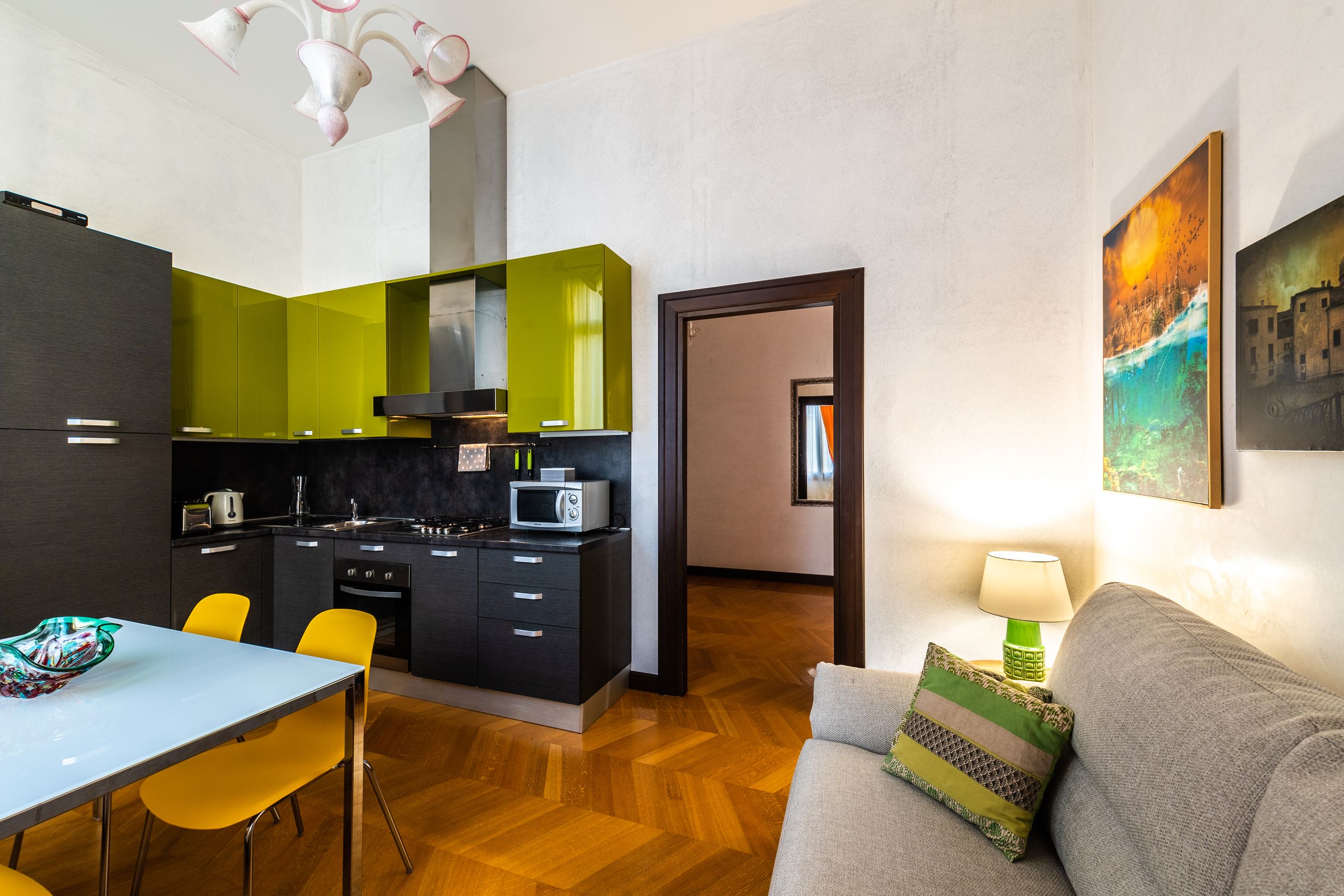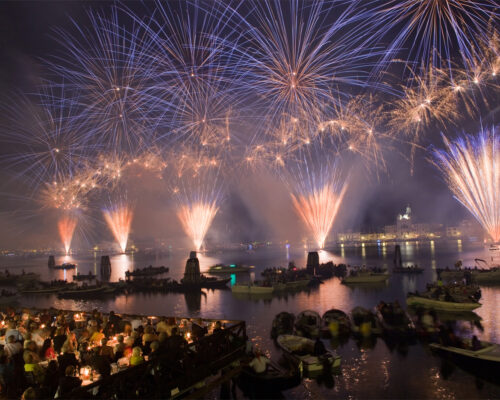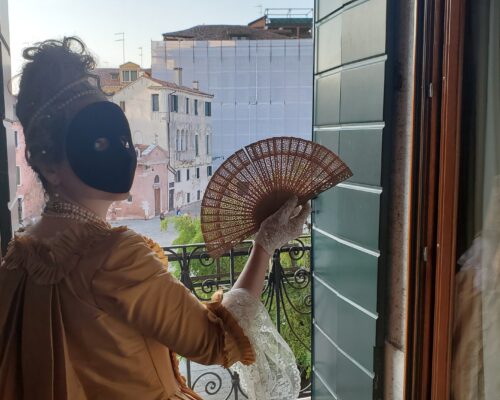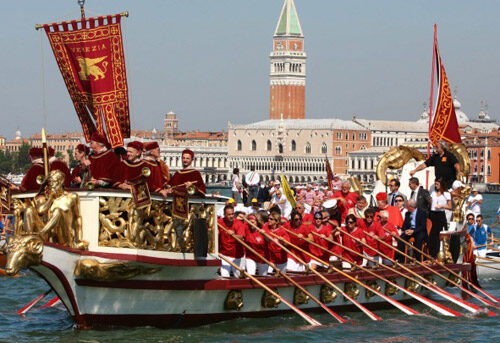
From 01/01/2022 to 31/12/2025
Feast of the Redeemer in Venice
Feast of the Redeemer in Venice
Venice experienced 4 waves of plague between 1348 and 1630.
There were thousands of deaths which prompted the government to establish the “lazarets“, places where the sick were kept in isolation.
After the third wave, a church dedicated to Christ the Redeemer was erected on the Giudecca Island as a plea for divine help. The church was designed by Palladio and built between 1577 and 1592.
The following year the city was finally declared free of disease, and so the Doge made the promise that every year, on the day Venice was freed from the terrible pestilence, a procession would be held to the new votive church.
On the third Sunday of July the tradition of building a 330-meter pontoon bridge to facilitate the pilgrimage to the Basilica, is still honored.
On the previous night (on Saturday) a firework display takes place in the basin in front Saint Mark ‘s Square, and the weekend ends with a gondola regatta.
The feast of the Redeemer is deeply felt, especially by the residents.
It is a popular tradition to start mooring in the Saint Mark’s basin as early as late afternoon, all boats are usually brightly decorated for the celebration, local dishes are prepared (Sarde in saor, creamed cod, risi e bisi, etc.) and people enjoy singing and dancing till the start of the “Foghi”. (fireworks)
From a raft moored near the Giudecca Island, at a safe distance from the boats, the fireworks display begins at 11.30 pm sharp.
Such an impressive event that will certainly leave you awestruck in just the same way it has always amazed all Venetians.
On Saturday, just for our guests, Ca’ Sant’Angelo Apartments organizes an outing in the San Marco Basin by private luxury boats with only 8 seats available. Seated comfortably on leather sofas you can enjoy the unique view of this spectacular event.
Imagine yourself in this motionless mirror of water, enveloped by the night and illuminated by the stars … we are just waiting for you to join us.
 |
|
From 01/01/2022 to 31/12/2026
The Carneval of Venice
The Carneval of Venice
The Carneval of Venice is one of the oldest events of the Serenissima Republic of Venice, evidence of which can be found in a document by Doge Vitale Falier dated 1094.
It was a moment of leisure and lightheartedness granted by the Venetian authorities to the people, especially to those of the poorer classes,
Masks and costumes ensured anonymity and therefore freedom from social status and even the mockery of public office was accepted.
For a few days, the Carnival represented an excellent way out from a condition of moral repression and public order under which the Republic of Venice held its citizens.
In our modern times, the Venice Carnival usually takes place from the end of January until the period of Lent.
During Carnival, you will find parties and music in the many small squares around the city (campi) and, of course, in the most important square of Venice, Piazza San Marco. Many historic buildings will also become home to very elegant private parties.
The typical mask of the Venice Carnival is the “Bauta”, all white, was traditionally worn by both men and women combined with a black hat called “Tricorn “and a long cloak called “Tabarro”.
Many make-up artists, scattered around the streets of the city, will transform your appearance in a few moments.
From entertainment we move on to the art of eating, naming some of the most traditional Venetian dishes:
- sarde in soor (sardines in a sweet and sour marinade)
- risi e bisi (rice and peas)
- baccala` mantecato (creamed cod)
- fegato alla veneziana (Venetian-style liver)
Ca’ Sant’ Angelo Apartments is the perfect accommodation for your stay during the Carnival festival. Thanks to our central location and the typical atmosphere of a traditional Venetian palazzo, our visitors can be truly taken back to the Venice of the 14th century.
Should you decide to visit us in any other time of the year we still offer an ideal location for the main attractions of the city.
Just press this link to book now
 |
|
From 01/01/2022 to 31/12/2026
The Marriage of the Sea Ceremony in Venice
The Marriage of the Sea Ceremony in Venice
Another very ancient tradition, dating back to around the year 1000, is “The Marriage of the Sea”.
The Doge, at the head of a solemn procession of boats, sailed across the lagoon to reach the Lido port. In front of the San Niccolò Church, the patron saint of sailors, the Doge’s head was sprinkled with holy water and a prayer was recited so that the sea would be merciful to Venetian sailors.
As a commemoration of the” Marriage of the sea”, the ceremony is now performed by the Mayor of Venice, between the end of April and the end of May, depending on when Easter is celebrated.
He crosses the lagoon aboard the “Bissona” (a ceremonial barge), followed by a procession of boats and reaches San Niccolò Church, where he throws the ring blessed by the Patriarch into the sea.
In the Saint Mark Basilica, in Venice, a ring found in recent times is kept as evidence of what has been narrated about this ancient ceremony.
In case you decide to partecipate to this event, please contact us as soon as possible.
 |
|
From 29/03/2023 to 31/12/2033
What you can see in Venice in three days
What you can see in Venice in three days

I want to give you some advice, as a professional host, but above all as a Venetian resident, on what you can see in Venice in three days. Based on our apartments, you can set out to discover the most famous monuments of the historic centre.
It helps a lot to plan things to do in advance, what to see and above all to buy tickets online avoiding queues.
This is the link where you can buy tickets online.
It may be convenient, perhaps if you are a small group of six or seven people, to book an authorized guide who will take you to discover the Venice treasures.
Now let’s start.
Day 1 – In the morning we begin from San Marco Square, the famous one which for many years was the economic, religious and political center of the city. In this place there are historic buildings within a short distance that the whole world envies us. The Basilica of San Marco with its golden mosaics dating back to the 11th century. The visit takes about 40 minutes, but beware of public holidays, when the morning is dedicated to worship.
Palazzo Ducale, the Doge’s residence and center of power of the Serenissima. This is the most visited Venetian museum ever and it is open every day. It is connected via the famous Bridge of Sighs to the “Palazzo delle Prigioni”; here the prisoners heaved a long sigh as their end was certain. Opposite is the Bell Tower of San Marco, called by the residents “el paròn de casa” and the Clock Tower
You will have the possibility to purchase individual tickets for each single venue or purchase a combined ticket for all the museums in Piazza San Marco: Palazzo Ducale, Museo Correr, Museo Archeologico and Biblioteca Marciana.
– In the afternoon, walking along the “Riva dei Sette Martiri” you can reach one of the oldest islands in Venice, San Pietro di Castello. This “Riva dei sette Martiri” takes its name from a historical fact that occurred during the Second World War, in August 1944. In that period a German soldier disappeared (who was later found to have fallen into the water because he was drunk) and the German command decided to have seven political prisoners shot in retaliation. Here we are in the Castello district and returning towards the Rialto Bridge you will be able to visit the Cloister of San Francesco della Vigna, the Church of San Giovanni e Paolo and the very small Church of Miracoli. It is nicknamed “the marble church” and the waiting list to get married in this jewel is very long. A short distance away is the historic Rialto Bridge and it will be possible to go up to the Fondaco dei Tedeschi and, upon reservation, it will be possible to go up to the roof, free of charge, to admire the panorama of the Venetian roofs.
Day 2 – In the morning you can visit the Natural History Museum or the Jewish Ghetto with its synagogues (online booking is recommended). In this place in Venice, during the period of the Republic of Venice, starting around 1516, the Jewish communities were forced to live. Being a small place, when a family increased, other apartments were built above the previous ones. The considerable heights of the buildings are the highest ever in the whole city. Nearby you will find “bacari” where you can take a break and eat something typical: creamed cod on crusty bread, grilled cuttlefish, fish balls and perhaps a good glass of prosecco.
Afternoon To rest a bit after lunch, I recommend a gondola ride, it costs 80 euros for 30 minutes until 18:00, after which it costs 100.00 euros. The price is the same from 1 to 6 people. You can also choose a water taxi at your complete disposal. The cost up to 4 people for one hour is 130.00 euros. After having rested there, I would visit the Chiesa della Salute, the Peggy Guggenheim Collection, the Squero di San Trovaso, one of the last sites where gondolas are built and finally the basilica Dei Frari with its precious paintings.
Day 3 – Full day to the three major islands of Venice: Murano, Burano and Torcello. You can start with the closest island of Murano, famous for its glass production. All the glass factories that once were also present in the historic center have found their headquarters on this island. Because of the fires that sometimes occurred, it was decided to transfer them all to an island so as to limit the risk of fire spreading to the inhabited centre. On this island you will also find the church of San Pietro Martire, the Cathedral of Santa Maria e Donato and of course the Glass Museum. You can calculate about 3 hours the time needed for the visit.
From here you can reach the island of Burano where you will certainly find an excellent fish restaurant: Trattoria Alla Maddalena, Al Gato nero or da Romano just to name a few. After lunch, a walk through the center, among the colored houses and where you will find many lace shops, produced by local handicrafts. Other typical products are the Bussolai Buranei, typical sweets of the island. Its attractions are the Church of San Martino Vescovo and the Lace Museum. You can calculate at least 4 hours, lunch included, to visit Burano island.
Then continue to Torcello, a very small island, to which we owe the origins of the first settlements of the peoples fleeing the invasions. Here we find the Torcello Museum, the bell tower and the church of Santa Fosca. A couple of hours are enough to visit all these places and finally you can get to your apartment, of course Ca’ Sant’Angelo apartments.
|
|

